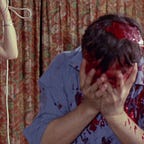Sylvester (A.K.A. New Year's Eve)
This article contains spoilers.
The German Expressionist filmmakers of the 1920s were hoping to morph cinema into a purely visual artform, one that didn't use words to tell its stories. They aspired to make film a universal language. In doing so, many filmmakers in Germany opted to ditch the use of intertitles in their films. The most famous example of this is F.W. Murnau's The Last Laugh, which would arrive at the end of 1924. Last year, I covered Arthur Robison's Warning Shadows, which featured many of the same cast and crew from Murnau's Nosferatu.
A more obscure example of this movement was the film Sylvester, which premiered in Berlin on January 3rd, 1924. It doesn’t really have the surreal Expressionist styling you might expect. Actually, it’s one of the earliest examples of Kammerspiele, a more realist movement, focused on the lives of middle-to-lower-class families in Germany. The film is set on New Year’s Eve, and it later went under the title New Year’s Eve. Funny how it was released after the New Year.
The film is set mostly inside a pub, where the owner, Sylvester, and his (nameless) wife are preparing a celebratory dinner in their backroom apartment. The wife notices the silhouette of a woman waiting by their window. She cannot distinguish the woman through the frosted glass, and assumes it is Sylvester's mistress, spurring her jealousy. However, Sylvester invites the woman inside, and she is much older than expected. She turns out to be Sylvester's mother. The reconciled family have a pleasant dinner together before the wife gets drunk and passes out on the couch.
Even at just shy of an hour, the film is quite slow and uneventful. The characters shuffle around the apartment without saying a word, just looking miserable. Much of the runtime is spent waiting for something to happen. It seems to be an exercise in how to pad a film out to an hour.
The film opens with an establishing shot of the pub, which then pulls away to show a wide view of the street. It seems to be a live city street, complete with a high rail-bridge in the background. You can even see the camera waiting for cars to pass before crossing the street. If this is a backlot, then Bravo! Either way, it's an impressive shot.
However, the film keeps cutting back to scenes of celebrations across the city, and the camera tracking down the street, all of which linger on and don't further the narrative. There's really only enough material in here for a two-reeler.
Halfway through the film, something finally does happen when the mother rages at her daughter-in-law, feeling that she was robbed of her son. The two of them get into a fight. When Sylvester arrives, the women stop their row, and the wife orders the mother to leave. But Sylvester stands by his mother, spurring the wife to storm out the door, with their baby, whose existence I wasn't even aware of until this point. Sylvester runs after his wife and convinces her to return.
After a while, the tensions rise again as the wife and the mother fight over Sylvester's affection, devolving into a tug-of-war with his body. Sylvester pushes the both of them aside and walks out the door, locking it behind him. The women begin to panic and try desperately to pry the door open.
The clock strikes midnight, and the drunken patrons barge into Sylvester's home to wish him a Happy New Year. That's when they discover the reason for the women's panic. His body lies dead on the floor outside.
The film was directed by Romanian-born Lupu Pick, who was something of a Renaissance man, writing, producing, directing, and acting in over 50 films throughout the 1910s and '20s. His wife, Edith Posca, starred in many of his films, and her final role was as Sylvester's wife.
The most notable name attached to the film is screenwriter Carl Mayer, who also wrote The Cabinet of Dr. Caligari and several Murnau classics like The Last Laugh and Sunrise. A very influential figure in the development of German cinema, and film language overall.
It's not difficult to see why New Year's Eve was forgotten. It's a drawn-out exercise in tedium that has no business being feature length. Perhaps it would be more engaging if we could hear the emotions of these characters, or the hustle and bustle going on outside, or even just a simple music score. As it is, the film is only available to view online in a poor VHS transfer, without any musical accompaniment. Only watch this if you're a die-hard fan of German cinema, and only when a remastered print is released.
